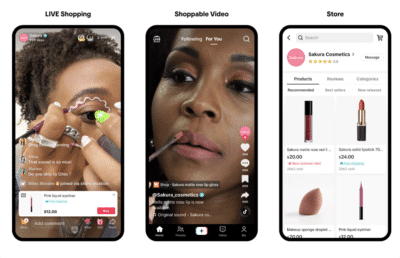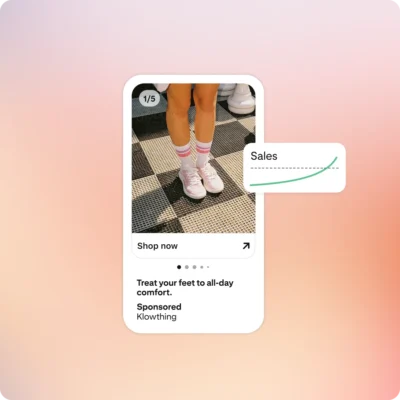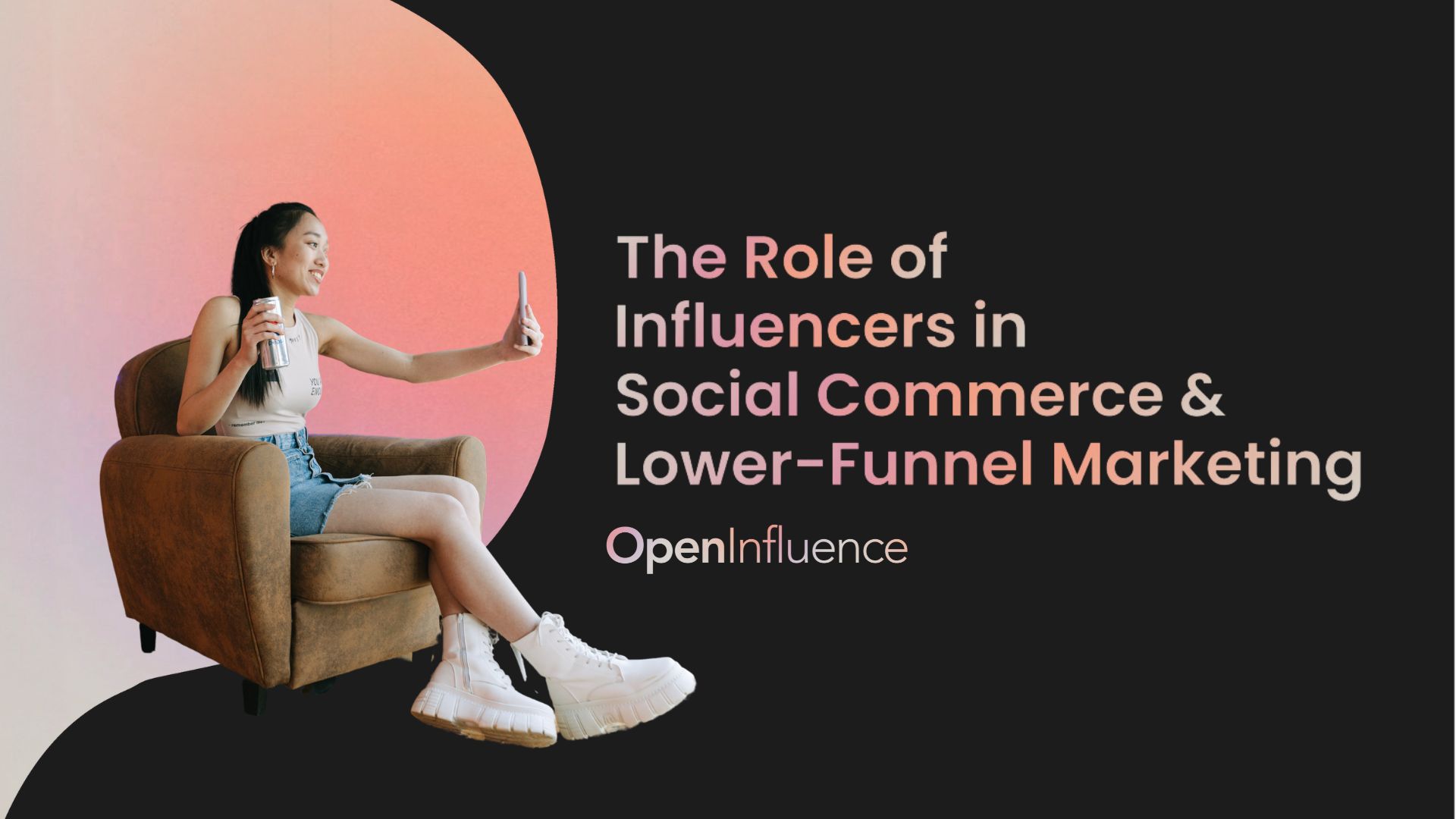How Creators Fit Into the Conversion Stage of Social Commerce
Defining the Terms
Before examining the role of influencers in social commerce and lower-funnel marketing, we will define exactly what each of those means.
Social commerce refers to buying or selling goods or services directly via social media platforms, with the entire process—from discovery through completing the transaction—taking place on those platforms, meaning that the buyer never has to leave the application.
Most leading social platforms have rolled out dedicated social commerce tools, easing the process for both buyer and seller and encompassing stages in the purchase journey including discovery, reviews/ratings, sharing, recommendations, finalizing transactions, and participating in loyalty programs.
Lower-funnel marketing—also referred to as bottom-of-funnel marketing, or the conversion funnel—is aimed at capturing potential customers who have gone through the discovery and research phases of the journey and are close to deciding on a product or service.
Those being targeted are usually already aware of the brand or provider through research, and lower-funnel marketing campaigns are meant to provide the final push to purchase.
The Evolution of Social Commerce
Shortly after the launches of Facebook in 2004 and YouTube in 2005, Yahoo tried to kick-start the concept of social commerce with Shoposphere, intended as a community where shoppers could share comments, insights, and reviews on products that were listed.
Early internet giants like Yahoo quickly began losing ground to upstart social networking sites like Facebook, which took its own unsuccessful social commerce shot with the original Marketplace in 2007, a destination for classified listings.
Things began to heat up in 2015, when Facebook introduced groups specifically geared toward buying and selling, while sister app Instagram rolled out a buy button that directed shoppers to off-app destinations where they could complete their purchases.
The following year brought Instagram’s debut of the ability for brands to tag products with pricing information, as well as Facebook’s reintroduction of the Marketplace we know today.
Instagram took things to another level in 2018 with shoppable posts containing a user-friendly checkout feature, and the two apps, now under the Meta umbrella, continued innovating in the space, joined by newer platforms.
Virtually every social media app now offers features such as shoppable catalogs, shoppable live and on-demand videos, and the ads mentioned in the definitions section that allow the entire transaction to take place on the app.
Upper-Funnel Creator Marketing
Upper-funnel marketing, or top-of-the-funnel marketing, refers to the awareness stage, where the aim is to make potential customers aware of the brand and the benefits offered by its products and services.
Brand awareness is the top objective, with key performance indicators to track including engagement, impressions, and reach.
Creators can contribute to upper-funnel campaigns with content such as unboxing videos that let them share all the details about a product with their audiences, and they can use tactics including branded hashtags to help build awareness and drive users to more posts about the brand or product.
Influencers with larger follower counts may be a better fit at this stage, as they can expose the brand, product, or service to more people, but niche creators bring the benefit of being more likely to reach people who are interested in the category.
Mid-Funnel Creator Marketing
Middle-of-the-funnel marketing is also referred to as the consideration stage, as potential customers have already been made aware of the brand, product, or service, and they are at a point in their journey where they are considering their options.
At this stage, brands should be thinking about providing in-depth information about their goods or services, determining whether they meet potential customers’ needs, and building trust between the two parties.
Calls to action must be well thought out, with a clear goal and a clear path to bring customers there.
Creators can contribute content including detailed videos or livestreams, product demonstrations or reviews, contests or giveaways, and behind-the-scenes access, and the success of their efforts can be tracked via metrics such as engagement rate and likes-to-comments ratio.
While macro-influencers can still be valuable here, the further down the funnel a brand moves, the more likely it is that they will find creators with smaller but more engaged follower bases to be the best vehicle for their campaigns.
Lower-Funnel Creator Marketing
As we described above, lower-funnel marketing, or bottom-of-the-funnel marketing, is the last push to conversion, as the potential customers being targeted are already aware of the brand, product, or service, and have learned enough about it to consider pulling the trigger.
“While top-of-the-funnel influencer marketing activity is extremely important for brand awareness, consideration, and brand affinity, bottom-of-the-funnel activity can often be linked directly to dollar signs, which, in my experience, is what transforms CEOs from angry to happy,” Open Influence Associate Creative Director Gem Garcin said. “Bottom-of-the-funnel activations can more easily prove out return on investment when revenue is an important factor.”
Marketing tactics at this stage include discounts for that final nudge, as well as clear, direct calls to action, like “buy now.”
Creators can collaborate with brands on content such as product reviews or testimonials, offers, and promotions, and influencers with follower counts of all sizes can be deployed in various ways.
“From a talent perspective, we would typically utilize lower-tier influencers for engagement/action, as opposed to higher-tier, who are better for reach/awareness,” Open Influence Director of Partnerships Tommy Johnson said. “I would say the paid side is especially important for getting people further down the funnel, too, with a traffic/conversion KPI.”
Metrics used to measure the success of campaigns include:
- Conversion rates: How many people purchase the product or service being promoted.
- Acquisition costs: The average amount spent to convert a lead into a paying customer.
- Customer lifetime value: Total net profit projected from a customer throughout their relationship with the brand.
- Other KPIs: website clicks, form submissions, click-through rates, engagement, and foot traffic lift for brick-and-mortar stores. For campaigns promoting mobile apps, add app downloads, in-app activity, and purchases.
Content from creators should include elements like affiliate links, discount codes, tags, and trackable landing pages to better enable more accurate measurement.
Creators’ Role in Social Commerce Marketing
The social commerce train is roaring down the tracks, with eMarketer projecting that the $67 billion in revenue it tallied in 2023 will soar to more than $144 billion by 2027.
Creators help keep that train from derailing, providing brands with direct access to a more engaged audience, with the authentic, relatable content they produce proving more effective than the traditional brick-and-mortar or ecommerce shopping experience.
Influencers curate catalogs of products they like, and customers can browse through those catalogs, with the creator receiving a cut of every sale.
Recommendations from creators are a key driver of purchases, so brands are enlisting creators to directly promote their products and boost conversions.
Deloitte said in its 2023 Creator Economy in 3D study that 47% of respondents will visit a brand’s website after engaging with a creator endorsement of that brand, while Morning Consult found that 53% of Generation Z shoppers it surveyed make purchases after viewing product reviews on social platforms.
Creators are playing the role of virtual sales-floor associates, not only promoting products, but also reviewing and testing them, and letting customers know about discounts.
Morning Consult found that “product haul” videos drive 40% of Gen-Z shoppers to make purchases, while that figure is 37% for “get ready with me” videos.
Creators foster a community around brands, creating spaces where followers can discuss, share, and engage with products, and turning individual purchasing decisions into collective experiences.
Brands have been leaning into longer-term partnerships with creators, rather than one-off posts or campaigns, and those collaborations sometimes advance past merely producing content.
How Platforms Enable Lower-Funnel Marketing
TikTok
TikTok continues to evolve from a discovery vehicle to a full social commerce marketing platform.
TikTok Shop officially debuted last September, after months of testing. Affiliate marketing represents the primary way brands and creators work together on TikTok Shop, with brands turning over a percentage of each sale to creators promoting their products. Commission rates usually fall between 5% and 20%.
The three ways for creators to promote and sell products on TikTok Shop are livestreaming, shoppable videos with links to the products, and product showcases at the top of the creator’s profile.

Credit: TikTok
TikTok provided perks to help kick-start TikTok Shop such as free listings, free shipping, warehousing space, and zero commissions.
The platform is also subsidizing all purchases to drive new users to TikTok Shop, and a new feature on the app prompts users to download a dedicated TikTok search shortcut and add it to their device’s home screen.
Facebook and Instagram
Parent company Meta scuttled its live shopping features on Facebook in August 2022 and on Instagram in March 2023, shifting its focus to advertising offerings like including Shop ads with in-app checkout, as well as new tools such as ratings and reviews and dynamic product pages.
On Instagram specifically, the Shop button and the personalized Shopping page it brought users to were shelved in favor of shopping features that directly drive advertising, which present users with shoppable content and multiple checkout touchpoints.
One of Instagram’s newer ad formats is multi-advertiser ad carousels, which show people a series of ads for related products from multiple brands.
Meta also introduced augmented reality ads for Facebook Reels and Stories and instagram Reels, giving brands a way to better engage with users.
YouTube
The Google-owned video platform shifted its social commerce marketing gears last spring, eliminating its product tagging feature, which enabled creators to add shoppable links to their videos, while expanding its affiliate program to all creators.
YouTube’s affiliate program enables creators to earn commission from products featured in their videos, similar to TikTok Shop, and the platform said the move was made in the hopes of attracting more creators and mining those creators’ strong relationships with their followers.
YouTube Shorts are included in the affiliate program, and the short-form video format’s in-app shopping tools resemble those of TikTok, making it easier for brands and creators to repurpose short-form videos across both platforms and reap the benefits.
New shopping features announced in April include Shopping Collections, which let creators curate products from brands they like or their own product lines. Those Shopping Collections appear in the creator’s product list, Store tab, and video descriptions.
The new Affiliate Hub in the YouTube app gives creators access to the most recent list of shopping partners, along with information like competitive commission rates and promo codes, and the ability to request samples from brands.
Pinterest CEO Bill Ready said during the company’s fourth-quarter-2022 earnings call that its goal was to embed shopping into every experience on its platform, particularly the surfaces with the most traffic: its home feed, personalized recommendations, and search functionality.
The eventual goal is for every Pin—particularly those including video—to be shoppable.
An optimization to pages that Pinterest introduced in late 2022 automatically serves users more ads when they demonstrate an intent to purchase.
Pinterest also streamlined consumers’ path to purchase by bringing them directly to merchants’ product pages.

Credit: Pinterest
Third-Party Partners and Services
The social commerce marketing ecosystem has spawned hosts of third-party service providers, many of which are integrated into social platforms, and many of which have entered into partnerships with brands and agencies, including Open Influence.
Their offerings include:
- Streamlining the process and ensuring the accuracy of conversion tracking.
- Providing studio facilities and related services for agencies, brands, and creators looking to dive into shoppable livestreamed videos.
- Creating custom storefronts, curated by creators, to facilitate transactions, as well as collect valuable first-party data on customers.
- Co-branded landing pages for affiliates and influencers, creating a similar dynamic to the TikTok affiliate marketing initiative detailed above.
- The creation of deep links and QR codes for any social platform or app without requiring the use of a software-development kit.
- Tailored, customized solutions to help agencies, brands, and creators bridge the gap between commerce and content.
Best Practices for Low-Funnel Creator Marketing
- Be sure that the audience being targeted is the most likely to convert, based on previous upper- and middle-funnel efforts, and ensure that the messaging delivered to them is personalized.
- Use a cross-platform approach rather than limiting outreach to one or two platforms.
- Use calls to action to achieve the desired results, adding elements such as discount codes, exclusive deals, or limited-time offers, where applicable.
- Think visual-first and ensure that images or videos capture the attention of users.
- Don’t forget organic social media, which can be an effective driver of engagement and conversions when paired with paid campaign efforts.
- Incorporate testimonials from customers, where possible.

